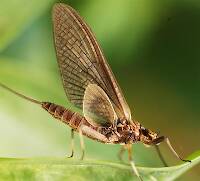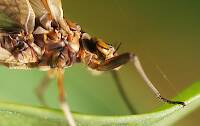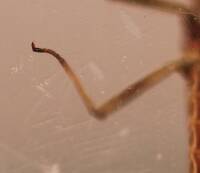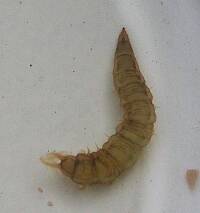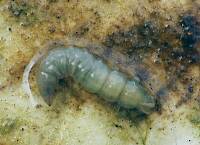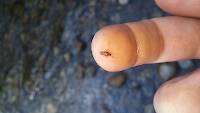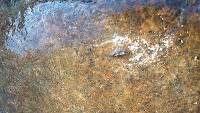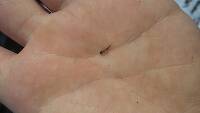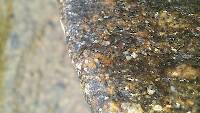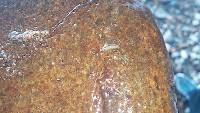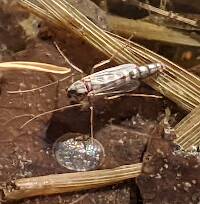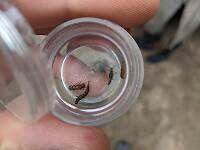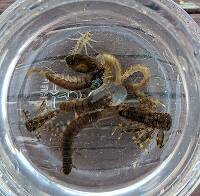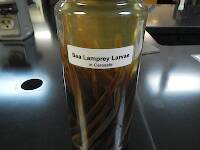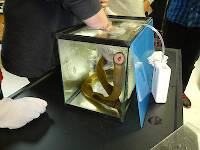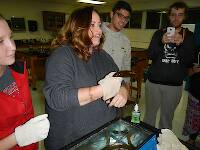
Hex Mayflies
Hexagenia limbata
The famous nocturnal Hex hatch of the Midwest (and a few other lucky locations) stirs to the surface mythically large brown trout that only touch streamers for the rest of the year.
Featured on the forum

This is the first of it's family I've seen, collected from a tiny, fishless stream in the Cascades. The three species of this genus all live in the Northwest and are predators that primarily eat stonefly nymphs Merritt R.W., Cummins, K.W., and Berg, M.B. (2019).

Troutnut is a project started in 2003 by salmonid ecologist Jason "Troutnut" Neuswanger to help anglers and
fly tyers unabashedly embrace the entomological side of the sport. Learn more about Troutnut or
support the project for an enhanced experience here.
And on Jun 4, 2008June 4th, 2008, 10:20 am EDT
Dear all,
inspite I have been asking many sources already I have not yet been able to indentify this mayfly. Last day a friend sent me a pitcure of a mayfly he came across in the Yellowstone at Mammut hot spring last July. Well it looked just the same, even though I pictured mine in central Germany. Confiding in your competence I try to the gather your input too.
Hope is ok if instead of posting the pics I put a link to them becasue they 9 pics
http://www.euroflyangler.de/html/private/eff/effimera.php
thanks in advance
Andrea
inspite I have been asking many sources already I have not yet been able to indentify this mayfly. Last day a friend sent me a pitcure of a mayfly he came across in the Yellowstone at Mammut hot spring last July. Well it looked just the same, even though I pictured mine in central Germany. Confiding in your competence I try to the gather your input too.
Hope is ok if instead of posting the pics I put a link to them becasue they 9 pics
http://www.euroflyangler.de/html/private/eff/effimera.php
thanks in advance
Andrea
Taxon on Jun 4, 2008June 4th, 2008, 3:00 pm EDT
Andrea-
Your photos are probably of Heptagenia sulphurea.
Your photos are probably of Heptagenia sulphurea.
CaseyP on Jun 4, 2008June 4th, 2008, 3:02 pm EDT
whew! you've got some competition, Jason! well worth the small trouble to copy and paste the link. when do we get this gorgeous specimen on a calendar?
"You can observe a lot by watching." Yogi Berra
And on Jun 5, 2008June 5th, 2008, 12:33 am EDT
Hi Taxon,
I'd exclude H.sulphurea for according to my sources it is small (10 to 14mm)and have no brown longitudinal stripe on the back
any other guess ?
thanks a lot
Andrea
I'd exclude H.sulphurea for according to my sources it is small (10 to 14mm)and have no brown longitudinal stripe on the back
any other guess ?
thanks a lot
Andrea
Taxon on Jun 5, 2008June 5th, 2008, 5:06 am EDT
Andrea-
That's my only guess. So, how long are they, anyway? Perhaps I missed it, but I didn't think you mentioned any length. That information would likely be useful to others.
That's my only guess. So, how long are they, anyway? Perhaps I missed it, but I didn't think you mentioned any length. That information would likely be useful to others.
And on Jun 5, 2008June 5th, 2008, 9:20 am EDT
Hi Taxon,
I am now in front some literature (mayflies of central Europe - Bauernfeind & Humpesch). In fact I wrongly reported earlier on today about the lenght of E.sulphurea, it is given bewtween 9-12 mm. Sorry, I had it wrong on top of my head.
The one in the picture is at least 15 mm (as visible in the picture number 2). The book reports also that in E.sulphurea all the femora are uniformly gray-yellow colored, without bandage or spots (which are instead visible in picuture 9). As well, according to other sources the abdomen (sternite)of E.sulphurea shows no signs or dots (visible on picture 6).
One thing in favour of E.sulphurea and that match with the schema shown on Mayflies of central europa are the genitalia though. If this is enough to categorize I do not know. Looking forward to further opinions
thanks so far
Andrea
I am now in front some literature (mayflies of central Europe - Bauernfeind & Humpesch). In fact I wrongly reported earlier on today about the lenght of E.sulphurea, it is given bewtween 9-12 mm. Sorry, I had it wrong on top of my head.
The one in the picture is at least 15 mm (as visible in the picture number 2). The book reports also that in E.sulphurea all the femora are uniformly gray-yellow colored, without bandage or spots (which are instead visible in picuture 9). As well, according to other sources the abdomen (sternite)of E.sulphurea shows no signs or dots (visible on picture 6).
One thing in favour of E.sulphurea and that match with the schema shown on Mayflies of central europa are the genitalia though. If this is enough to categorize I do not know. Looking forward to further opinions
thanks so far
Andrea
And on Jun 17, 2008June 17th, 2008, 7:44 am EDT
Hello
I think I solved my conundrum, this is Heptagenia flavia
Andrea
I think I solved my conundrum, this is Heptagenia flavia
Andrea
And on Jun 19, 2008June 19th, 2008, 7:19 am EDT
Sorry for the typo I meant Heptagenia flava
Also the hatching period matches, I took in this pics in May.
The dark stripe on the back is typical on the H.longicauda too but this latter shows up later in the year (July).
Andrea
PS Jason your pictures of the Hexagenia limbata have something that recalls a lot to the pattern of H.flava, the strip on the back and yellow edge on the front wing and the darker margin on the back of the rear wing.. I wonder if they had some common evolution lines :) after all 250 milion year ago there was still Pangea
Also the hatching period matches, I took in this pics in May.
The dark stripe on the back is typical on the H.longicauda too but this latter shows up later in the year (July).
Andrea
PS Jason your pictures of the Hexagenia limbata have something that recalls a lot to the pattern of H.flava, the strip on the back and yellow edge on the front wing and the darker margin on the back of the rear wing.. I wonder if they had some common evolution lines :) after all 250 milion year ago there was still Pangea
Quick Reply
Related Discussions
Topic
Replies
Last Reply
3
Mar 22, 2015
by Pookie025
by Pookie025
2
Apr 20, 2020
by DangerAF1
by DangerAF1
5
Dec 10, 2016
by PaulRoberts
by PaulRoberts
0
Mar 31, 2008
by Fish4va
by Fish4va
1
Apr 12, 2018
by Partsman
by Partsman




